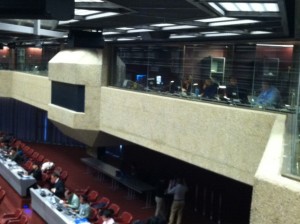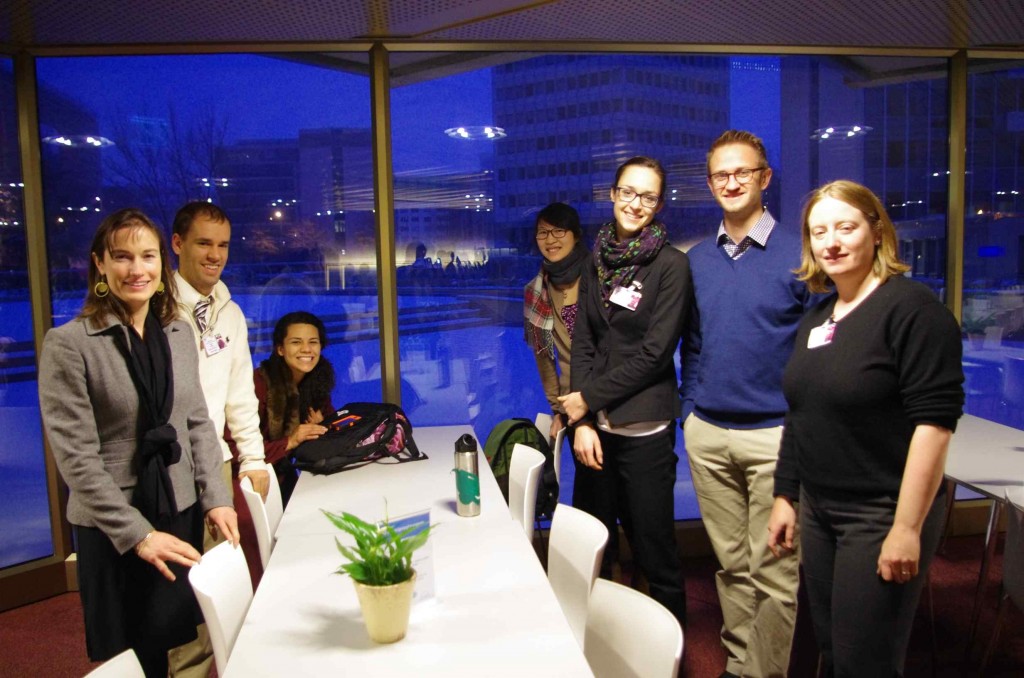By: Julie van der Hoop
INC5 is over, and I’ve returned home to campus. Though friends have been asking me questions about my experience, and how I got the opportunity to attend the negotiations, there has been one question that comes up almost every time: How many languages are spoken in a UN negotiation and how do you understand them?
Last week, I had the opportunity to interview Mr. Pedro-Jose Espinosa, the chief interpreter at the United Nations Environment Programme (UNEP) headquarters in Nairobi. After post-graduate education in law and economics, Pedro moved to Geneva and switched careers. First, he worked for UN translation services, and then became involved in interpretation. “Experience in law and economics is helpful,” he said, though interpretation is often a “third level career” – one that people come to after a first or second job. Some enter immediately after attending education programs specifically for interpretation and translation but, he said, “anyone can do it.” Assuming, of course, they speak several languages.
Some Basics
The UN has six official languages: English, French, Spanish, Arabic, Russian, and Chinese. Two of these languages, English and French, are the working languages of the UN, meaning they are used in day-to-day communication. This is because the language of diplomacy has historically been French but, within the last 50 years, English has become dominant.
Any official texts, such as Conference Room Papers (CRPs), are translated into all official languages. The treaty text is likewise available in these six languages, but all references are made to the English version of the treaty. As the Legal Group works only in English, this version is the official ‘legally-binding’ text to be used in negotiations and tribunals.
This leads us to a point of clarification: translation deals with text, and interpretation refers specifically to the spoken word.
Interpretation in the Conference Center
In booths at the back of the conference room, interpreters listen to delegates as they speak into their microphones; they then interpret what is being said and communicate this back to attendees, who listen through headphones and select the language they want to hear. Interpreters derive meaning from their “passive” languages — i.e., the languages spoken by the delegates—and convey the meaning of what is being said in their “active” language.
But interpreters don’t have to know all of the official languages – at a minimum, they only need to know two. In planning an interpretation team, the chief must match up different abilities to create a working relay system. One interpreter may go from Arabic to English, and another from English to Chinese, as there may be no one on staff who can interpret straight from Arabic to Chinese. “The amount of relaying must be minimized,” said Pedro. “You don’t want it to become a game of ‘telephone’.”
Interpretation is simultaneous, meaning that the language is interpreted as the delegate is still speaking; there is no intermediate pause to allow an interpreter to convey a message. Because of how exhausting the job is, interpreters switch off in half-hour shifts, and work seven ‘half-days’ out of the ten in a five-day work week.
And on the other three ‘half-days’? “We recuperate and prepare,” Pedro said.
Preparation is key to success in interpretation: knowledge of the meeting topic is extremely important in putting things in context and being familiar with jargon. “Technical meetings are the most difficult,” both in understanding and in interpreting what negotiators are saying. For example, knowing the difference between HFCs, CFCs, or HCFCs is critical to ensure proper communication in climate change negotiations.
Challenges
The job doesn’t come without challenges. Keeping pace with a speaker can be extremely difficult when many delegates read from written statements on the floor. When people read, they speak much faster than when they are just talking, which makes it difficult for an interpreter to hear, process, and repeat the speech fast enough. Accents can also be plaguing – just consider the number of accents in English. Australian, Jamaican, and Japanese delegates all communicate on the floor in English, so an interpreter must be able to understand all of the various accents in a single passive language.
And if an interpreter is at a loss for words? “There are strategies for coping,” according to Pedro. An interpreter can continue with the speech, and fill in whatever meaning might have been lost. “Interpreting is not translating,” Pedro said. Paraphrasing is often needed as there are words and sentiments that do not have full equivalents in all languages. In the end, “it’s the message that counts.”


